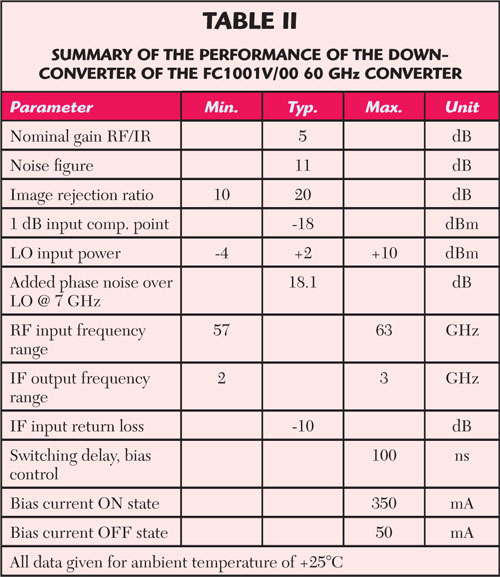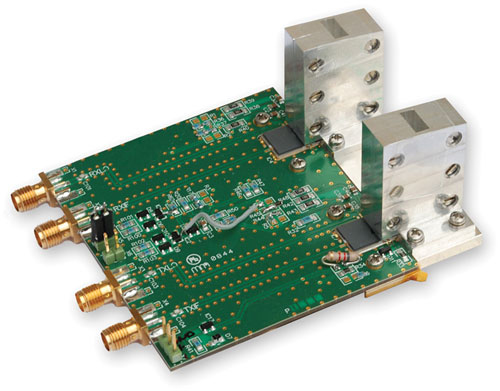 In recent years, the 60 GHz band has gained increased interest due to the large amount of license-free and little used frequency spectrum located in the vicinity of 60 GHz. A particular feature of this band is the high attenuation in air, close to 15 dB/km, regardless of weather conditions. This high attenuation makes the 60 GHz band less suitable for some applications, but for many other systems it is beneficial. Today, the most common commercial 60 GHz product takes the form of license-free and high-speed (1.25 Gbps) wireless Ethernet links.
In recent years, the 60 GHz band has gained increased interest due to the large amount of license-free and little used frequency spectrum located in the vicinity of 60 GHz. A particular feature of this band is the high attenuation in air, close to 15 dB/km, regardless of weather conditions. This high attenuation makes the 60 GHz band less suitable for some applications, but for many other systems it is beneficial. Today, the most common commercial 60 GHz product takes the form of license-free and high-speed (1.25 Gbps) wireless Ethernet links.
Due to the high attenuation these links benefit from reduced co-channel interference, and thus shorter cell re-use distance, which is of the utmost importance in a dense urban environment. Another application where the high attenuation is beneficial is secure communication, when the transmitted signal will vanish in the noise floor after a controlled distance determined by the user. Thus, in practice, it will be impossible to overhear the communication outside a well defined range of operation.
To address such applications, Sivers IMA has developed a new broadband 60 GHz converter that is a very versatile building block for high-performance 60 GHz applications. The converter is linear and can thus accommodate almost any modulation scheme that the user desires. It is capable of 64QAM transmission at 60 GHz and consists of one up-converter and one down-converter in a single unit. These two converters work independently and can thus be used in both frequency multiplexed and time multiplexed applications.
Features and Performance

Figure 1 Block diagram of standard FC1001V/00 60 GHz converter.
The 60 GHz converter employs single-chip transmitter (up-converter) and receiver (down-converter) MMICs for reliable and consistent performance. The chip-set used allows for high-volume production of the converter with minimal manual tuning of the individual modules required. A block diagram of the standard FC1001V/00 60 GHz converter is shown in Figure 1.
As a unique feature, the user has full control of frequency selection by choosing an appropriate external LO source. Frequency multipliers (×8) are integrated in both the up-converter and down-converter. The LO injection is effected at 7 GHz with +0 dBm power. The unit has two separate inputs for the LO signal, one for the up-converter and one for the down-converter.
Each input accepts an input signal in the range between 6.75 and 7.625 GHz. With this range it is possible to fully cover 57 to 63 GHz, while maintaining a full operational IF bandwidth of 1 GHz centered around 2.5 GHz. The up-converter and down-converter accepts LO power levels between -4 to +10 dBm. However, a nominal level of +2 dBm ±2 dB is recommended for best performance.
The applied LO signals determine much of how the converter is implemented in a system. Some systems require very low phase noise, while others must be frequency agile (Frequency Division Duplex (FDD) requires a different LO for the up-converter and down-converter, etc.). The user needs to select the output or input operating frequency and choose a LO source with 1/8th of that frequency. The phase noise at 60 GHz band is readily calculated as the phase noise at the applied 7 GHz LO frequency +18.1 dB, due to the ×8 frequency multiplication within the converter. By using a high-quality LO synthesizer provided by Sivers IMA, 64QAM transmission has been demonstrated with the standard 60 GHz converter.
A set of two identical FC1001V/00 converters can be used in a full duplex configuration by the appropriate choice of LO signals for the up-converter and down-converter modules, respectively. The user also has access to a bias control input for both the up-converter and down-converter. This feature enables Time Division Duplex (TDD) operation by independently turning OFF the up-converter and down-converter when not in use. The bias can be turned ON and OFF in less than 100 ns from a CMOS gate, operational amplifier or comparator. The user may also use this control to save DC power by switching off the up-converter and/or down-converter when in idle mode.
The FC1001V/00 is intended as a sub-unit to be integrated into a user application. For easy handling, the unit is furnished with standard SMA connectors for IF and LO signals. The output is a standard WR-15 waveguide flange UG385/U for easy connection to other equipment or antennas. It is also possible for the user to remove the waveguide adapter flange and use the waveguide exciters (probes) as low gain antennas.
A summary of the performance for the up-converter (transmitter, Tx) and down-converter (receiver, Rx) part of the standard FC1001V/00 60 GHz converter is shown in Tables 1 and 2, respectively.


Variants of the Standard Converter
Sivers IMA has a long history of designing and manufacturing custom-made systems. Thus, the standard FC1001V/00 60 GHz converter can be tailored to fit the specific needs of the customer. One straight-forward example is shown in Figure 2 where the standard FC1001V/00 is equipped with +10 dBi horn antennas. In this configuration the product number is FC1001V/01. Apart from the functionality found in the standard FC1001V/00 converter, additional functionality such as a mechanical housing, high-quality LO synthesizer, additional DC circuitry, and gain-control circuitry may be ordered and included.

Figure 2 60 GHz converter with optional +10 dBi horn antennas (FC1001V/01).
The mechanical housing is typically designed according to the needs of the customer and provides efficient dust and weather protection. The integrated high quality synthesizer may result in a frequency resolution as small as 0.1 kHz of the 60 GHz signal. The additional DC circuitry allows for a single-input DC feed between +10 to +18 V, which makes the handling of the module even simpler. The gain-control circuitry allows for gain and output power variation over a 32 dB range or more.
Conclusion
The standard FC1001V/00 60 GHz converter is a broadband, versatile 60 GHz converter for multi-purpose use. It can be utilized in all applications where a seamless 60 GHz converter is needed. Applications include diverse areas such as high speed (several Gbps) point-to-point links, secure communication, measurement systems, electronic warfare and lab usage. Furthermore, the converter can be customized to fit the exact needs of the customer.
Sivers IMA AB
Kista, Sweden
Tel: +46 8 7036800
sales@siversima.com
www.siversima.com
US contact: Tel: (603) 878 4566
brucelbaker1@comcast.net.
RS No. 301
